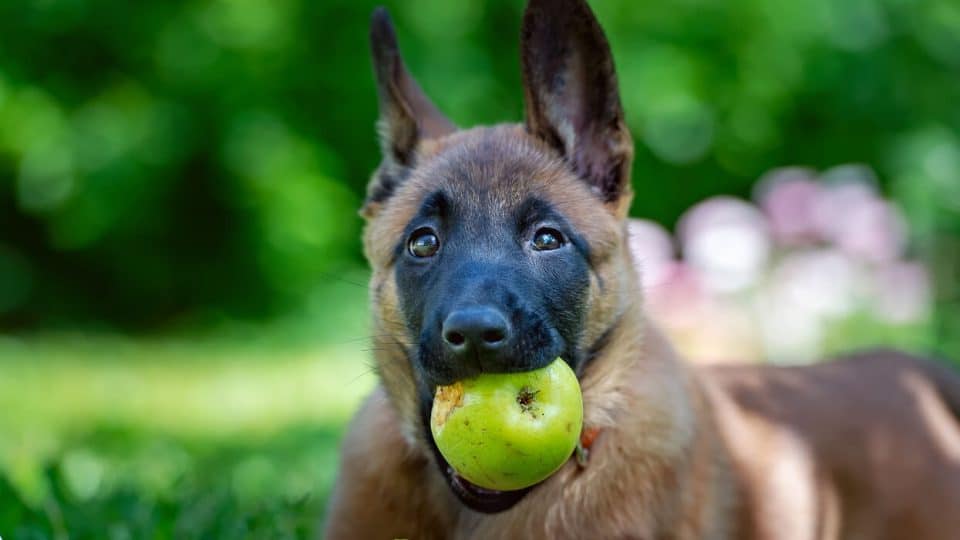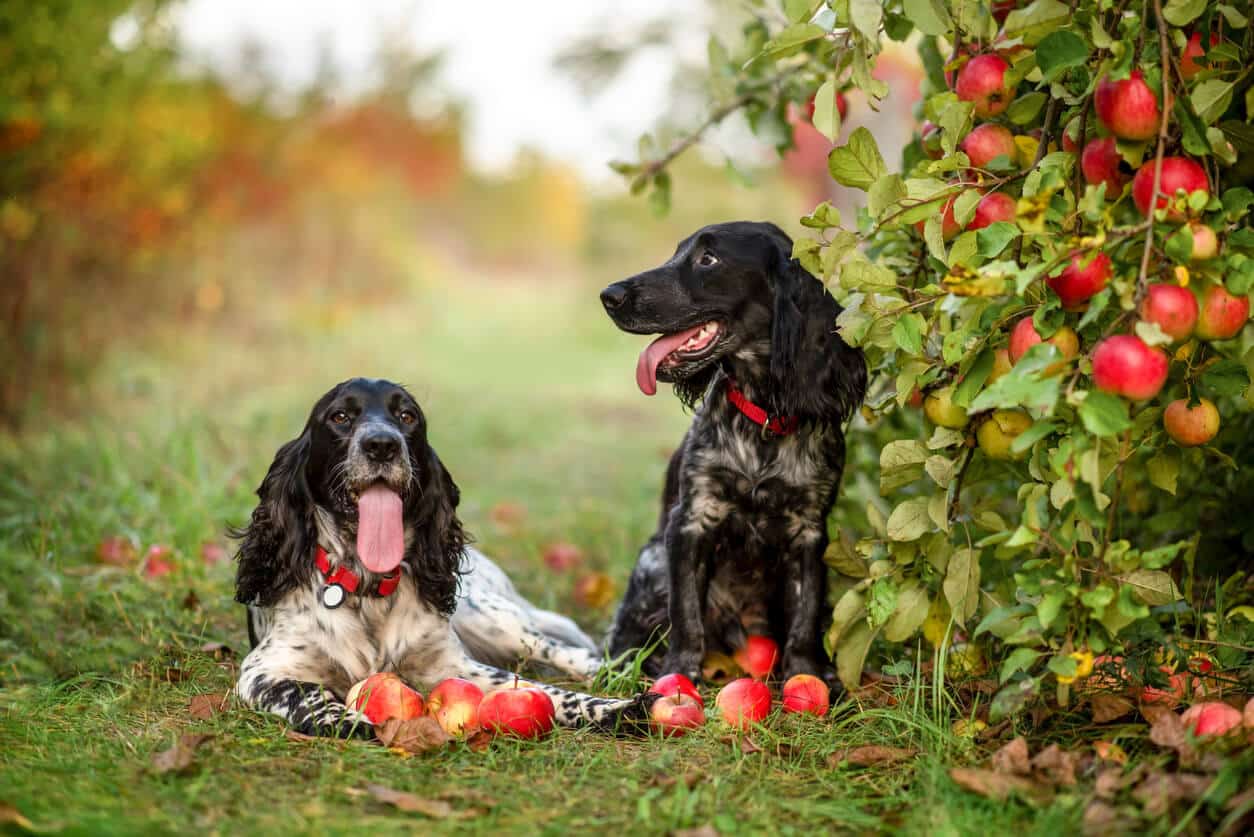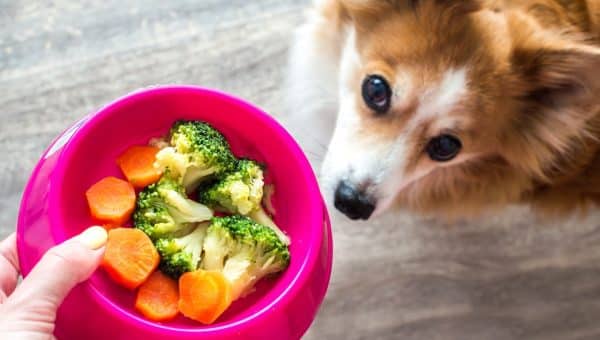- Not a substitute for professional veterinary help.
You’ve just crunched into a crisp, juicy apple when you catch your dog staring at you. As with many of your favorite foods, they want a nibble for themselves—and they’re in luck, because it’s perfectly safe for dogs to eat apples. Not only can dogs eat apples, this fruit makes a great treat for your pup.
Apples are packed with antioxidants, and some evidence links eating apples with a lower risk of asthma, diabetes, and heart disease. That said, it’s important to keep a few safety tips in mind before you feed your dog apples.
Read on to learn which parts of an apple are safe for dogs to eat and why this fruit can be a good snack for dogs, according to Dr. Linda Simon, a member of the British Royal College of Veterinary Surgeons.
Are Apples Good For Dogs?
“An apple is a tasty snack that dogs enjoy, and apples also have some health benefits,” Dr. Simon says. “They contain some fiber, which helps promote a healthy gut and can lead to more formed and solid stool. They’re a source of vitamin C, which can promote a more robust immune system.”
Dr. Simon says apples also contain vitamin A, which the body uses to support vision, the immune system, and bone growth. Just leave the peel on when sharing apples with your dog, since most of an apple’s nutrients come from its skin.
The amount of nutrients in three apple slices:
| Nutrient | Amount per slice | Benefit |
| Vitamin A | 2.25 micrograms (µg) | Supports vision, immune system, and bone growth |
| Vitamin C | 3.45 milligrams (mg) | Supports immune system |
| Fiber | 1.6 grams (g) | Promotes a healthy gut |
Trying to decide between green and red apples? Dr. Simon recommends choosing a green apple, since they contain more vitamin A and less sugar than red apples.
Apples on their own won’t do much to improve your dog’s health, but a small amount of this fruit does make a great alternative to processed dog treats.
Of course, keep in mind that if you feed your dog a nutritionally balanced commercial dog food, they’re already getting all of the vitamins, minerals, and other nutrients they need for optimal health.
Can Dogs Eat The Whole Apple?
You won’t want to give your dog an entire apple, since they shouldn’t eat some parts of this fruit.
In the chart below, Dr. Simon outlines which parts of the apple dogs can eat safely.
| Apple part | Can a dog eat it? |
| Flesh | Yes |
| Skin | Yes |
| Seeds | No. They contain trace amounts of cyanide. Swallowing a few seeds generally won’t hurt your dog, but it’s best to avoid giving them any apple seeds all the same. |
| Core | No. The core contains seeds and can pose a choking hazard, especially for smaller dogs. However, if your dog accidentally grabs an apple core, you probably don’t need to worry. |
| Stem | No. It has no real nutritional value and may get stuck between your dog’s teeth. |
| Juice | Best avoided. It contains a lot of sugar and doesn’t offer the same nutritional benefits as whole apples. |
What if I live near apple trees?
If you have apple trees in your yard, you may worry about your dog getting their paws on stray apples that have fallen from the tree.
Your dog will probably be just fine if they snack on an apple or two. But if they eat too many apples, they could develop vomiting and diarrhea, says Dr. Simon.
Persistent vomiting and diarrhea can become serious, so it’s best to call your vet if you notice these symptoms.
The mold in fallen, spoiled apples can also pose a health risk for your dog, so it’s important to gather stray apples from the ground before letting your dog roam freely in your yard. And of course, it’s never a bad idea to supervise their yard playtime!
How Many Apples Can Dogs Eat?
Apples do make a nutritious option for dog treats, but they still contain sugar. Too much sugar can cause a shift in your dog’s gut which can lead to diarrhea. So, you’ll want to limit the amount of apples you share with your dog.
As a general rule, veterinary nutritions suggest limiting your dog’s treats to just 10% of their daily calorie intake.
Not sure how many calories your dog eat each day? You can ask your vet for more guidance or use a calorie calculator. For example, a healthy dog who weighs 65 pounds should get about 1240 calories (kcal) per day. Their treat allowance, then, would be about 124 kcals—about one medium apple.
Do Apples Pose Any Risks For Dogs?
Even though apples are packed with nutrients, you’ll want to note a few safety considerations.
“The leaves and other parts of the tree and seeds of apples contain a toxin called amygdalin that can cause cyanide poisoning,” says Dr. Renee Schmid, DVM, Senior Veterinary Toxicologist at Pet Poison Helpline.
Dr. Schmid explains that the seeds need to be chewed and broken down in the stomach before any risk of poisoning develops.
In other words, if your dog chews one or two seeds from apples grown for human consumption—an apple you buy in a store or local market—poisoning from the seeds is unlikely. Apples grown in the wild may contain higher amounts of amygdalin, however, so these are best avoided.
Swallowing an apple core and seeds whole may pose a risk for obstruction, depending on the size of your dog and the size of the pieces they swallow.
It’s always a good idea to pay close attention to your pup after you introduce something new into their diet, though Dr. Schmid says it’s very rare for apples to cause an allergic reaction in dogs. Most food allergies in dogs develop with protein-containing foods, and apples have very little protein.
How To Prepare Apples For Your Dog
Apples are incredibly versatile. Just make sure to remove the stem, core, and seeds before giving them to your dog (or eating them yourself)! Both dogs and people should only eat the skin and flesh of the apple.
Dogs can eat apples:
- Fresh: Cut them into bite-size pieces to prevent choking.
- Mashed: Create your own homemade applesauce by stewing the apples.
- Frozen: Dogs may enjoy a frozen apple slice as a refreshing treat on a hot summer day.
- Dried: Dehydrate thin apple slices in your oven or air fryer for a convenient snack for you and your dog.
- As treats: If you don’t have time to dry the apples yourself, you can pick up some store-bought apple dog treats instead. Just make sure they’re intended for dogs or that they have no added ingredients.
Important: The sugar content of cooked or dried apples can increase, so you may need to reduce the amount of apple you give your dog to avoid giving them too much sugar in one day.
3 Appetizing Apple Recipes for Dogs
Apples make a great base for homemade dog treats, since their stickiness helps bind other ingredients together.
Fun recipes to make with your furry sous chef include:
What Other Fruits Can Dogs Eat?
There are many other safe and delicious fruits your dog can enjoy, including:
Just avoid giving your pup grapes, raisins, and currants! These are toxic to dogs.






